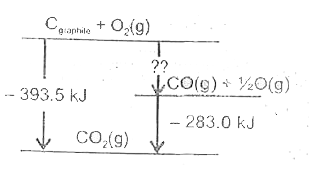Enthalpy change for reaction
1/2H2(g)+1/2Cl2(g)→HCl(g) is called :-
Enthalpy of combustion
Enthalpy of solution
Enthalpy of formation
Enthalpy of fusion
The correct Answer is:3
To determine the enthalpy change for the reaction:
12H2(g)+12Cl2(g)→HCl(g)
we need to identify what this enthalpy change represents. Let's analyze the reaction step by step.
Step 1: Understand the Reaction
The reaction involves the formation of hydrogen chloride (HCl) gas from its elements, hydrogen (H2) and chlorine (Cl2).
Step 2: Define Enthalpy of Formation
The enthalpy change associated with the formation of one mole of a compound from its elements in their standard states is known as the standard enthalpy of formation.
Step 3: Identify the Components
In this case:
- The reactants are 12H2(g) and 12Cl2(g).
- The product is HCl(g).
Step 4: Relate to Enthalpy of Formation
Since the reaction describes the formation of one mole of HCl from its constituent elements in their standard states, it is classified as the standard enthalpy of formation of HCl.
Conclusion
Thus, the enthalpy change for the given reaction is called the enthalpy of formation.
Final Answer
The correct option is C: Enthalpy of formation.
---
The reaction involves the formation of hydrogen chloride (HCl) gas from its elements, hydrogen (H2) and chlorine (Cl2).
The enthalpy change associated with the formation of one mole of a compound from its elements in their standard states is known as the standard enthalpy of formation.
In this case:
- The reactants are 12H2(g) and 12Cl2(g).
- The product is HCl(g).
Since the reaction describes the formation of one mole of HCl from its constituent elements in their standard states, it is classified as the standard enthalpy of formation of HCl.
Thus, the enthalpy change for the given reaction is called the enthalpy of formation.
The correct option is C: Enthalpy of formation.
Topper's Solved these Questions
Similar Questions
Calculate the enthalpies change for the reaction,
H2(g)+Cl2(g)→2HCl(g)
Given that, bond energies of H-H,Cl-Cl and H-Cl are 436, 243 and 432 kJ mol−1
View SolutionThe enthalpy change for the reaction 2C(graphite)+3H2(g)→C2H6(g) is called
View SolutionThe enthalpy of formation of ammonia is −46.0KJmol−1 . The enthalpy change for the reaction 2NH3(g)→N2(g)+3H2(g) is :
View SolutionCalculate the enthalpy change for the reaction
H2(g)+12O2(g)→H2O(g)
if the bond energies of H−H,O=OandO−H bonds are 104, 118 and 11 kcal mol^(-1) respectivley.
View SolutionThe enthalpy and entropy change for the reaction: Br2(l)+Cl2(g) to 2BrCl(g) are 30kJmol−1 and 105JK−1mol−1 respectively. The temperature at which the reaction will be in equilibrium is:-
View SolutionThe enthalpy and entropy change for the reaction,
Br2(l)+Cl2(g)→2BrCl(g)
are 30KJmol−1 and 105JK−1mol−1 respectively. The temperature at which the reaction will be in equilibrium is:
View SolutionThe enthalpy and entropy change for the reaction
Br2(l)+Cl2(g)→2BrCl(g) are 40kJmol−1 and 110JK−1mol−1 repectively. The temperature at which the reaction will be in equilibrium is
View SolutionThe enthalpy and entropy change for the reaction,
Br2(l)+Cl2(g)→2BrCl(g)
are 30KJmol−1 and 105JK−1mol−1 respectively. The temperature at which the raction will be in equilibrium is:
View SolutionCalculate change in enthalpy for the reaction at 27∘C
H2(g)+Cl2(g)→2H−Cl(g)
by using the bond energy and energy data
Bond energies of H−H,Cl−Cl and H−Cl bonds are 435kJmol_1,240kJmol−1 and 430kJmol−1 respectively.
View SolutionA schematic representation of enthalpy changes for the reaction,Cgraphite+12O2(g)→CO(g) is given below. The missing value is

View Solution
